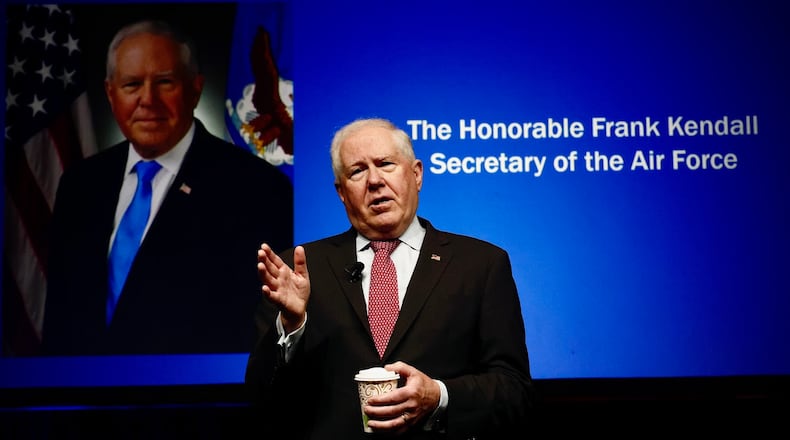New or reoriented organizations will be placed where people already work, although there may be changes “at the margin,” Kendall said. And Wright-Patterson is already home to some 35,000 military and civilian employees, the largest mass of employment in a single location in the state of Ohio.
“People certainly don’t need to be worried about an exodus from Dayton,” Kendall told the Dayton Daily News in an exclusive interview after his LCID keynote address. “On the other hand, I don’t see a mass influx either. I think it’s going to be fairly stable, as much as you would expect.”
As the Air Force reorganization (or “reoptimization,” as it’s called) to face China and Russia continues, the Air Force Materiel Command, headquartered at Wright-Patt, will remain the center of acquisition efforts, Kendall said.
“Its role is going to be central to both obtaining the operational capabilities we need and reoptimizing for great power competition,” he said.
His expectation is that the “critical mass of intellectual capital that the Air Force needs” will remain with AFMC, which is a global organization of some 89,000 people working with $72 billion of budget authority.
The Air Force Life Cycle Management Center will become the Air Force Air Dominance Systems Center. That massive organization will continue to be responsible for hardware, weapons and platforms across their life cycles.
A ‘bright future’
Kendall said he expects the renamed center to remain at Wright-Patt.
“I don’t see anything but a bright future for Dayton. I think there’s a lot of capability here, terrific support from the community and a very well established network of both industry and government civilians who support the Air Force extremely well,” he said.
A self-described “technocrat” and former U.S. Army officer who spent three years commanding a battery in Germany at the height of the Cold War, Kendall, a West Point graduate, oversees an Air Force budget exceeding $173 billion. He has spent more than 50 years working in engineering, management, defense acquisition, and national security in uniform, in private industry and in government.
He became Air Force secretary in the summer of 2021 after serving with companies such as Raytheon and Leidos and in positions such as under secretary of defense for acquisition, technology and logistics.
A seasoned Cold Warrior, Kendall and his team are returning the branch to a Cold War posture prepared to fight against China and Russia.
“I’m used to waking up every day worried about what the threat is doing and what we’re going to do to stay ahead of it,” he told this newspaper.
What Air Force “reoptimization” means for Wright-Patterson is a crucial question for the base and the Dayton area. But Kendall’s message to this newspaper was reassuring.
He sees no need for major change at the 88th Air Base Wing, the unit responsible for supporting and securing Wright-Patterson, even though the Air Force is looking at how it structures wing commands, particularly on operational bases where the service has a lot of war-fighting capability.
“The question there is, how do you set up the base so that the unit that’s going to deploy is ready to deploy as a unit, but also operates the base in peace time,” Kendall said. “At some of our big operating bases, we’re making some adjustments because of that. But Dayton (Wright-Patterson) is not as much affected.”
The 88th has more than 5,000 uniformed, civilian and contractor employees. Wright-Patterson’s only flying mission at the moment is the 445th Airlift Wing, an Air Reserve unit. Kendall says he does not see that changing at the moment.
He expects reoptimization to continue under a President Kamala Harris or a President Donald Trump.
“The (service) chiefs are fully supportive of it,” the secretary said. Air Force Chief of Staff “Gen. (David) Allvin often talks about, this is what he is going to be doing during his tenure. He is fully supportive. I think the acquisition community is fully supportive, as well. I’m not hearing any resistance to any of the changes we’ve made.”
Other topics addressed during Kendall’s interview with the Dayton Daily News:
Opposition to bringing Air National Guard and Reserve troops into Space Force: Kendall acknowledges the opposition surprised him. “The change we’re making with the Guard, or trying to make, is very small. It’s half a percent, roughly.”
He added: “We should have communicated better with governors. I’ll take the heat for that.”
He also said: “Creating a ‘Space Guard’ for 578 people doesn’t make any sense. So we need to get to a solution that’s good for the people.”
Continued growth at Wright-Patterson: “I expect stability to be more likely than change, as far as personnel are concerned. I think if we do make changes, it will be on the margins, and I don’t think they’re going to be large in either direction.”
The importance of the National Air and Space Intelligence Center and the National Space Intelligence Center at Wright-Patterson: “I get an intelligence briefing every single day, and very often it’s a NASIC briefer coming in to brief me on some specific area of expertise.”
On visiting Dayton/Wright-Patterson three times in the past three months: “We had a corona (session with generals) meeting here, and I think I came to speak at one of Duke Richardson’s events (Gen. Duke Z. Richardson, AFMC commander).”
On dealing with the media (mentioned during his keynote address): “When you start feeling comfortable with a reporter, shut up.”
About the Author


